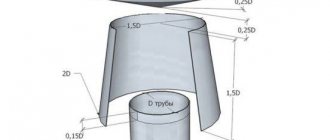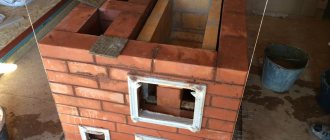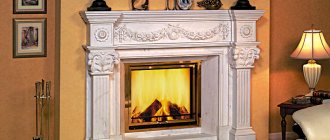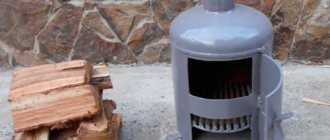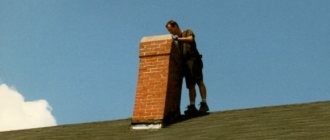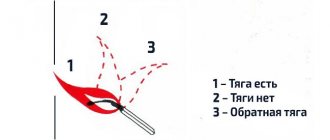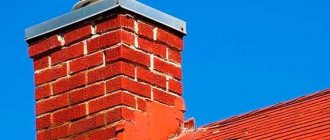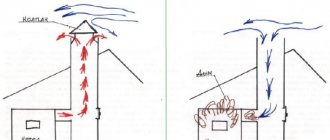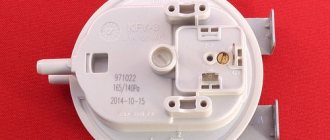Most heating systems in the private sector are wood, coal or gas stoves. To work effectively, it is important to take many points into account. Let's consider one of the most problematic - there is no draft in the chimney: what to do to correct this situation. Let's get acquainted with the common causes of faulty smoke exhaust and how to eliminate them in each specific case.
An example of deteriorating draft in a fireplace Source blogspot.com
Useful information about chimney draft
All residents of country or private city houses are familiar with the concept of chimney draft. Do they know the essence of this term?
If we move a little away from the dry scientific terminology, then draft can be defined as a natural phenomenon in which air moves from one area to another, namely, from an air zone with high pressure to a zone with low pressure. All this happens with the help of a ventilation device - a special channel in the chimney.
Using this process of aerodynamics, humanity began to use fireplaces, stoves, boilers, heating their homes using different types of fuel - coal, firewood, peat, etc.
With good draft, the stove lights up quickly and the room is filled with pleasant warmth.
The following depends on a properly designed and constructed chimney and, accordingly, on good draft:
- quality of room heating;
- reduction in fuel costs;
- safety in buildings with their own heating.
What influences the value
There are three groups of factors that must be taken into account when constructing and inspecting a chimney.
In-house moments
A number of factors indoors can significantly influence the presence/absence of draft and its strength:
- The material from which the building is constructed.
- Average room temperature.
- The maximum volume of air space in the home.
- The number of people permanently staying inside the dwelling.
- The presence of internal sources that additionally consume oxygen (heaters, heaters, stoves, etc.).
- Regular supply of fresh air (airing, ventilation).
External factors
There are other factors that determine the chimney draft, and they are located outside the heated room. We are talking about external temperature, atmospheric pressure, humidity, wind direction. A phenomenon such as changing temperatures during the day can also affect draft - due to the movement of cold and warm layers of air.
Difficulties with traction appear for various reasons, some may simply not be noticed. For example, problems with air outlet through the chimney may arise if the pipe is located much lower than the ridge of the building or tall nearby trees.
Chimney design features
The draft may vary depending on the design characteristics of the chimney:
- height;
- presence of insulation;
- tightness;
- location (internal/external);
- length;
- presence/absence of irregularities or roughness, etc.
It is necessary and possible to control the draft in a room using the “levers” of the first and third factors (intra-house and design). Natural changes, of course, do not depend on humans.
Keeping the draft in the chimney under control is a prerequisite for safe and comfortable living in your own premises. If the draft is very weak, then it is almost impossible to light the stove and heat the home.
With reverse draft, the gases generated as a result of combustion are “thrown” into the living space, and not into the air through the pipe. This is very dangerous for human health and life!
It is impossible not to notice this atypical behavior of smoke
With very strong draft, all the heat is rapidly drawn out through the chimney channels, without having time to warm the heated room to the desired temperature.
Rose of Wind
A situation when the prevailing winds blow directly into the chimney and reduce the draft or reverse it. The chimney is installed on the windward side, of course, if the wind directions are determined. If the chimney is located far from the ridge and below, the leeward side cannot be used. Multi-storey buildings and trees also affect traction. To compensate for gusts of wind and poor placement of the chimney, anti-wind deflectors are used. According to the standards, the chimney is installed half a meter above the ridge. If the distance from the ridge is 1.5 m - 3 m, then it is brought to the same level as the ridge. If the distance is more than 3 meters, then proceed according to the formula: from the horizontal drawn from the ridge, 10 degrees down. In practice, the chimney is made higher than the ridge, or at the same level as the ridge. It is important to use one chimney for one stove in the house.
Why does reverse draft occur?
Weak thrust can become the basis for the formation of reverse thrust. How can you recognize that all is not well with cravings?
This is “spoken” by moments that can be seen with the naked eye: a lot of smoke in the stove, soot on the door, incoming smoke movement inside the house. In other words, smoke and fumes from the burning fuel do not go into the chimney through the chimney, but tend to enter the living space when the door is open and through cracks.
Causes of backdraft:
- Design flaws of the chimney. A low pipe means an increased risk of reverse draft. The higher the pipe, the better the process of extracting exhaust gases and smoke. The optimal pipe height is about five meters .
- Correspondence of the pipe diameter to the parameters of the furnace device. A powerful stove requires a chimney with a pipe of rather large cross-section. But the measure here is very important, because using a pipe that is too wide will make the combustion process unprofitable (all the warm air will literally fly into the pipe). It is unacceptable to use several pipes with different cross-sections in the chimney!
- Use of non-smooth pipes. Unevenness, chips, roughness, etc. are an obstacle to good traction. Over time, the chimney opening may narrow due to soot deposits and other combustion elements and complicate the process of lighting the stove and its normal functioning.
- Poor/lack of ventilation. Drafts and open windows in rooms located above the firebox do not help the fuel combustion process, but distort it, making it useless and unsafe.
Chimney channels made of metal are in many ways inferior to brick pipes. Rapid heating and equally rapid cooling are not good for the heating system in general and the chimney in particular.
Brick pipes are much more effective in terms of smoke extraction
Reverse thrust can also appear for objective reasons beyond a person’s control. Strong gusts of wind, rainy, cloudy weather with high humidity are unfavorable moments in terms of the formation of problems with traction.
There is such a term as temporary backdraft. What is this? In this case, it is worth talking about temporary traction disorders, lasting for several days. After a certain period, cravings return to normal.
Temporary reverse draft can occur due to a cold room that has been unheated for a long time. Very cold air accumulated in the chimney pipe prevents the fuel from burning quickly. Therefore, smoke can be “pushed” out of the chimney into a home, bathhouse or other room with a stove or fireplace.
It is very easy to eliminate cold air in the chimney - warm up the pipes by burning ordinary newspapers, wallpaper, and paper in the oven. The main thing is that these materials are well dried.
If problems with traction can be detected constantly or with a certain frequency, then it is necessary to take measures to eliminate bad traction.
Fire safety rules for installing and using a potbelly stove
Compliance with fire safety rules when using a potbelly stove will protect all residents from possible unpleasant consequences:
- The fuel must be dry only; flammable mixtures must not be used;
- ignition is carried out by slightly opening the combustion damper, adding the required amount of combustible material and, directly, ignition;
- sufficient combustion of the fuel makes it possible to regulate the power level of the furnace device by closing or opening the ash compartment;
- Cleaning the furnace from accumulation of ash is carried out when the body has completely cooled, by pulling out the ash drawer and throwing out the contents.
We recommend that you familiarize yourself with the material on our website: “How to make potbelly stoves for a bath yourself.”
- the first use of a potbelly stove will be accompanied by the smell of melting paint, but in the future this episode will not occur;
- things that have a highly flammable composition should be located at a distance of 1 m from the stove;
- within one load, you cannot put more than 3 kg of dry fuel into the combustion compartment, while the door must be closed;
- It is strictly prohibited to use a potbelly stove when detecting any malfunctions in the operation of the chimney;
- Leaving a heater in working condition unattended with children present in the room is prohibited;
- during operation, the body of the potbelly stove becomes very hot, so you cannot touch it;
- The installation of the stove structure is carried out only on a special base (pedestal) with non-flammable properties.
Strength check
Before you try to fight bad traction, make sure that your traction really leaves something to be desired.
You can check the traction using special devices or yourself. Simple ways to fix traction:
- Light a piece of paper and let it burn for a while. When you bring it to the stove or fireplace, extinguish the paper and observe the direction of the smoke. If it is directed towards the pipe - good thrust, deviates in the opposite direction - reverse thrust, if it remains “straightforward” - there is no thrust. Similar manipulations can be done with thin tissue or toilet paper without setting it on fire.
- If there are smokers in the house, then follow the direction of the cigarette smoke or the flame of a match or lighter near the fireplace or stove. Draw conclusions similar to the first point.
- The flame of an ordinary candle can also help in determining the draft in the home.
- A pocket mirror brought to the firebox and covered with condensation may indicate problems with removing smoke from the stove.
- The presence of too much draft, which carries away useful heat from the room, is indicated by an audible hum in the stove - a loud hum.
- The color of the fire in the firebox can be an indicator of different drafts. A golden hue means good draft, white flame means excessive draft, red color and black smoke means poor draft, high probability of reverse draft.
A regular lighter can help test traction
An anemometer is a device familiar to many people of the Soviet period. Using this device it was possible to measure the draft of the chimney. Readings within 10–20 Pa were considered normal. The disadvantages of the device are its low accuracy when the wind force is less than one meter per second.
This simple device will help protect your life in a stove-heated home.
Modern industry offers a sufficient number of devices for measuring draft; there are devices that record draft at the inlet and outlet of the chimney.
Forced exhaust by additional means
The need to install additional means of forced exhaust may arise for natural reasons, for example, trees have grown on the site, which has changed the direction or intensity of wind flows.
Watch the video
We increase chimney draft artificially
You can, of course, rebuild the house or redo the chimneys, but this path is very expensive and labor-intensive. It is easier and cheaper to use forced ventilation devices. To improve the hood, the following additional devices are used.
Troubleshooting Methods
If you have identified problems with traction, then, of course, they need to be eliminated as quickly as possible.
The choice of means to combat poor or reverse draft depends on the reasons that led to the abnormal operation of the chimney.
Pipe cleaning
One of the common methods of improving traction is cleaning the pipe. Fuel, burning in a stove, releases various substances that settle on the inner surface of the chimney. Soot sticks well to pipes if they are uneven or bent.
When carrying out work, do not forget about safety measures
How to clean a chimney so that there is good draft?
First of all, acting purely mechanically. The chimney channels can be made wider, getting rid of plaque, in the following ways:
- After preparing about one bucket of potatoes, peel and cut them. Potato peelings will also work. Throw a little into the firebox and wait. When burned, potatoes will release starch, which will become a means that can soften carbon deposits. Soft pieces of soot will fall off on their own, but firmly stuck ones will have to be removed mechanically.
- Firewood from aspen. Heat the stove with two or three logs. They will heat up the chimney pipes very much and help get rid of carbon deposits. But this method requires special care, since the likelihood of a fire will be very high (soot may ignite).
- Rock salt. This method is more suitable for prevention. Salt added at the time of combustion improves the condition of the chimney pipes.
- Pipe brush. A heavy weight is attached to a brush suspended on a steel rope and lowered into the chimney openings. By lowering and raising this structure, you can force soot formations to fly off the walls of the pipes and fall into the furnace. These fragments are then removed from the firebox.
The second group of anti-particulate measures is based on the use of chemicals. The most popular chemicals for cleaning chimneys are “Log-chimney sweep”, “Komichek”. Chemicals are added to the coals formed during the heating of a stove or fireplace according to the instructions and the heating continues. After all the fuel has burned out, it is advisable to leave the coals, since they continue to “work” in terms of cleaning the chimney (at least, that’s what the manufacturers advise).
When used correctly, chemicals will not cause harm to your home.
Do not believe the spiteful critics who talk about the obligatory combustion of soot when using the chemical method. This method does not pose any danger, since the beneficial effect occurs due to chemical reactions, and not due to the ultra-high combustion temperatures of the reagent.
Special mention should be made of the observance of safety measures when carrying out all work related to the chimney. Do not fix chimney problems in windy weather! Try to use safety devices when working at height!
Troubleshooting structural problems
If certain features of the chimney design are identified that negatively affect the draft force, adjustments should be made to eliminate them. These actions include:
- dismantling several separate pipes and installing a single chimney channel;
- adding roof pipes to the required height;
- insulation of chimney elements, etc.
Ventilation arrangement
In some cases, traction may improve if drafts are avoided in the house or bathhouse. You can help with draft problems by installing ventilation devices on windows.
If there is no desired effect after all the methods described above, you should adopt modern devices to improve draft in the chimney.
Installation of devices
To improve the operation of the chimney, it is best to use special devices that allow you to regulate and control the draft. Such devices can be bought in a store or made with your own hands.
How to determine the best option
The choice of a specific solution depends on the structural features of the chimney in each individual case. The use of elements such as deflectors, weather vanes, turbines or smoke exhausters is only relevant in the presence of certain factors, such as windy weather or the impossibility of arranging a full height chimney.
The best solution remains, as always, to increase the height of the chimney and use various stabilizers, which, in combination with increased draft, can ensure optimal operation of the boiler. In this case, the influence of external factors is reduced and all possible obstacles to the creation of a natural flow of combustion products are eliminated.
Special devices for regulation
Modern instrument makers have taken care of producing special devices that regulate chimney draft:
- Regulators. They are installed on the chimney outlet to normalize draft in the heating system, and also as a means of influencing the heating efficiency.
- Deflectors. Such devices are fixed to the chimney from the outside. The draft speed is improved due to the fact that the diameter of this device is much larger than the chimney pipe, and, therefore, an area of low pressure appears in it when air flows around it.
- Chimney weather vane. It is a special design that performs several functions at once: improves traction, protects the pipe from raindrops and snow whirlwinds. The operation of the device is similar to the operation of a deflector; the thrust speed is normalized by reducing external air resistance.
- Smoke fan. It is very popular among owners of houses with a heating system. An artificial air vortex is created inside the chimney due to the operation of the ventilation system, which requires electricity to connect. Compliance with all necessary safety measures is a prerequisite for the installation and operation of such a device to improve chimney draft.
All devices installed on the chimney pipe to improve draft require mandatory monitoring, especially in winter. This is due to the fact that additional devices attached to the chimney from the outside can become clogged, iced up (in winter) and thereby prevent the normal operation of the chimney. Blockage caused by devices can cause backdraft and the penetration of carbon monoxide into living spaces.
Do not forget to regularly inspect the chimney and devices that help increase draft.
Photo gallery: traction control devices
The most common device among stove heating users
This device is especially relevant for improving the operation of stoves and fireplaces.
Useful and beautiful device
By installing such a device, you can improve the performance of the entire heating system
Electric smoke exhausters
In some situations, for example, for use with wood-burning stoves or fireplaces, it is possible to install special electric duct exhaust fans. They are designed to operate in environments with elevated temperatures and the presence of ash, condensate and other combustion products. However, it is unacceptable to install them on the chimney of a boiler operating on solid fuel; the temperature of the gases in it can reach 650-800°C.
Such smoke exhausters are capable of automating the operation of the chimney. A special temperature and flow sensor regulate the activity of the electric drive, thereby always maintaining optimal traction in the system.
Solving problems yourself
Let's try to make the heating process safe and efficient with our own hands. The most common way to combat soot accumulation in pipes is with a brush and a sinker.
Cleaning the pipe with a brush
First, let's prepare everything you need:
- A hard bristle brush. The diameter of this device is selected taking into account the cross-section of the pipe (from fifty to three hundred millimeters).
- A thin metal cable (can be replaced with a very strong rope or rope).
- Weight for hanging from a brush.
This is what a device for cleaning a chimney pipe looks like
Do not start work if there is strong wind or too much humidity outside. Try to think through and use reliable insurance to protect yourself from unforeseen events.
The ruff is weighted using a sinker, attaching it to the bottom of the device. The brush itself is hung on a cable. All fastenings must be especially reliable, otherwise the structure will fall apart and you will have to perform additional actions - to “fish” them out of the pipe.
First, all inspection holes in the chimney are cleaned, and then they begin to clean the pipe itself. By making a few up and down motions, you can get rid of any soot that will fall from the chimney into the furnace. It is best to have someone else around the stove to signal efficiency and when to stop working.
Cleaning the pipe should be completed when the soot stops falling out.
You can also clean the pipe using improvised means, about which many videos have been made.
Video: cleaning a pipe with improvised means
Weather vanes or wind vanes for forced draft
This is a device to protect the chimney from wind. Its principle of operation is that, like any weather vane, it turns in the wind, protecting the head of the chimney from the wind flow. Flowing around this device, the wind itself creates a vacuum above the mouth of the chimney, thus creating a forced draft of the chimney.
The heat-resistant material for the manufacture of such a weather vane is usually stainless steel with a thickness of 0.5 millimeters. Rotation around the axis occurs on closed type support bearings that do not require maintenance. There is no condensation and no soot deposits on the device body.
However, it requires maintenance to clear the ice. The disadvantages of the design include unstable operation in strong winds. Under normal conditions, the vane fan operates steadily and efficiently, creating forced draft inside the chimney.
Selection of devices for regulation
Let's consider some characteristic features and methods of using devices for monitoring and adjusting traction.
Deflectors
Such structures are installed on the chimney (at its very top) to create obstacles to air flow. The intensity of the wind force drops noticeably when encountering such devices placed on a pipe. The smoke escapes through the channel “to freedom” due to weak air currents entering the pipe. These flows “catch” the exhaust gases and “push” them out.
Deflectors eliminate the possibility of pipe clogging, and, if made with taste, they significantly improve the appearance of the entire building.
There are several types of deflectors:
- TsAGI;
- round Wolpert;
- Grigorovich;
- plate-shaped;
- in the form of the letter H;
- rotating;
- vane.
Almost all of these devices are made from stainless steel, in rare situations - from copper. Using brackets, clamps, bolts, sealing tape, the deflector is attached to the chimney pipe. Some devices are also equipped with additional functions: to extinguish sparks (to eliminate a possible fire in the roof), to control the temperature of the exhaust air (in this case, the sensor is triggered if hot air does not come out and there is a possibility of reverse draft).
The disadvantages of using deflectors are their minimal effectiveness in calm weather.
Photo gallery: types of deflectors
The most common device for improving traction
Such a device can be purchased in specialized stores
The choice of device depends on the design features of the pipes and your preferences
Rotary devices
Turbines installed at the head of the chimney use the energy capabilities of the wind. Air flows set the rotary nozzle in motion (it always moves in one direction), and thereby the air becomes rarefied near the chimney. The entry of any foreign objects and sediment into the chimney with a rotary pipe is completely excluded.
Rotary pipes have a big disadvantage, similar to the operation of a deflector. Their use on a windless day is ineffective.
If you do not have great abilities, buying such devices is not a problem.
Traction regulators
Such devices are a real find for residents of country houses, lovers of baths and fireplace gatherings. These devices are attached to the boiler chimney. They are equipped with a metal plate with a weight that balances it on one side. When the draft is good, the metal plate does not interfere with the free access of air into the chimney. With weak or reverse thrust, the metal plate serves as a kind of stupor.
The range limits for thrust are set by the consumer himself, the usual parameters are 10–35 Pa.
The device operates completely autonomously and does not require any electrical current.
Rotary turbines
A special design consisting of rounded blades located at a certain angle to the axis of rotation. The turbine, under the influence of exhaust gases and external flows, always rotates in the same direction, maintaining and increasing thrust. The advantages and disadvantages are the same as for deflectors.
How to increase traction with your own hands: homemade devices
Before you start building a deflector yourself, weigh your strengths, review the available materials, and only then get down to business.
Drawings and diagrams
To create a deflector with your own hands, you need to use diagrams and drawings. You can use ready-made ones, which are presented in large quantities on the Internet, or you can do it yourself, relying on data from ready-made diagrams and drawings.
Photo gallery: ready-made diagrams of traction devices
On the Internet you can find good help for constructing the device.
Carefully study the device diagrams and choose the one that suits you
The diagram shows the structure of this traction improvement device
The diagram shows the components of this device
If you decide to test yourself and save money at the same time, arm yourself with measuring instruments to determine the internal diameter of the chimney. Depending on this value, using the table as a guide, you can determine the necessary parameters for the height of the deflector and the width of the diffuser.
With an internal diameter of 120 mm, these parameters are respectively 144/240, for a diameter of 140 mm - 168/280; if the internal cross-section is 200, then 240/400; for a cross section of 400 mm, you will need a deflector height of -480 mm, and a diffuser width of 800 mm.
You can calculate the necessary parameters (for a specific pipe diameter) yourself using simple calculations. To determine the width of the diffuser, the internal diameter of the pipe must be multiplied by 1.2; We consider the width of the umbrella for protection to be -1.7 x d; We find out the total height of the structure if we multiply the size of the internal section by 1.7.
Having received all the dimensions, we make drawings for more accurate cutting. We draw diagrams on a sheet of Whatman paper or on the back of the remaining pieces of wallpaper.
It is best to construct a life-size drawing. So that when cutting, you can simply attach the cut paper parts to the steel sheet and not have to recalculate the data taking into account the scale of the drawing.
We stock up on materials and tools
Everything needs to be prepared in advance so as not to be distracted during work.
To make the deflector we will need:
- galvanized sheet with a thickness of at least half a millimeter, stainless steel can also be used;
- metal scissors;
- drill with different drill bits;
- device for setting rivets;
- hammer;
- pliers;
- clamps, nuts, bolts;
- marker (for transferring the drawing onto a metal sheet).
Preliminary stage
The preparatory work consists not only in drawing out the details of the device, but also in cutting them out and trying them on. All paper elements are fastened with paper clips or a stapler and applied to each other. If everything fits, then you can carefully remove the fasteners and straighten the templates.
Do not be negligent in the process of creating a deflector; try to think about your safety. To avoid injuring your hands and to protect your eyes, use gloves and special glasses prepared in advance.
Let's get started
So, everything is in place, we can get started!
A step-by-step description of the sequence of actions will help you:
- We transfer the parts cut out of paper onto a galvanized sheet. We should get developments of the following elements: cap, diffuser, outer cylinder and stand.
- Using metal scissors, carefully cut out all the components of the deflector. In places where the cuts are made, the metal is bent with pliers to a thickness of half a millimeter and “passed” with a hammer.
- The diffuser, cap and cylinder blanks are rolled up and holes for fastening are drilled (if bolts are used). Connections are made using rivets or bolts; in exceptional cases, welding can be used (semi-automatic).
- To attach the cap we prepare 3-4 strips of metal. The dimensions of the strips are 6 by 20 cm. The strips, folded at the edges and tapped with a hammer, must be bent in the shape of the letter P. On the cap, five centimeters from the edge, drill 3-4 holes and secure the metal strips with bolts.
- The other ends of the galvanized strips must be attached to the diffuser, thereby “looping” the cap and diffuser.
- We insert the resulting structure into the shell.
You can watch the video about how to build a TsAGI deflector with your own hands.
Installing the deflector
After installation, the deflector is bolted to the roof so that it is not blown away by the wind.
Homemade and purchased models are assembled into a finished product below, before installation on the pipe. The aerodynamic structure is bolted to a round metal asbestos pipe; usually, 3 holes are made in the pipe for this purpose. If there is slight play, a clamp is used.
An adapter is used to mount the deflector in a brick pipe of rectangular or square cross-section. The device is tested after installation. The spark arrestor is made independently from a thin metal mesh or stainless steel sheet.
The diameter of the structure must be larger than the outlet of the pipe so that the deflector does not fall inside the channel and block the smoke exit. Rotary draft controls do not work well in cold regions with heavy snowfall. Icing interferes with the operation of the device. The devices are installed in accordance with technical standards and requirements.
Advantages
The automatic chimney draft regulator has a number of positive properties. With this device you will provide your heating system with:
- Safe operation of the boiler and the entire chimney system.
- Long service life.
- Much less harmful substances will be released into the atmosphere.
- When the valve is held half-open, air masses circulate unhindered.
- The stabilizer will function regardless of the method of traction - natural or forced.
- Fuel combustion occurs evenly, so there is no need to worry that the chimney may overheat.
- In weather accompanied by strong winds, there will be no pressure drops.
- There will be no unpleasant burning odors, because... the regulator will not allow them to enter the room.
- Loss of thermal energy is eliminated.
- You can install such a device even in low-temperature boilers.
Chimney draft stabilizer SWAG with tee
